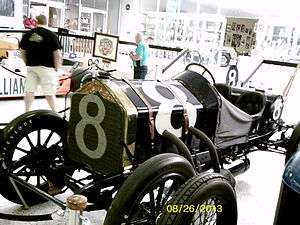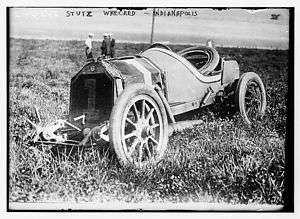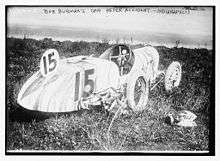1912 Indianapolis 500
|
| |||||
| Indianapolis Motor Speedway | |||||
|---|---|---|---|---|---|
| Indianapolis 500 | |||||
| Sanctioning body | AAA | ||||
| Date | 30 May 1912 | ||||
| Winner |
| ||||
| Winning Entrant | National Motor Vehicle Company | ||||
| Average speed | 72.457 mph (116.608 km/h) | ||||
| Pole position |
| ||||
| Pole speed | N/A | ||||
| Most laps led |
| ||||
| Pre-race | |||||
| Pace car | Stutz | ||||
| Pace car driver | Carl G. Fisher | ||||
| Chronology | |||||
| |||||







The 1912 Indianapolis 500-Mile Race, or International 500-Mile Sweepstakes Race, the second such race in history, was held at the Indianapolis Motor Speedway on Thursday, May 30, 1912.
No race is won until the tape is crossed and I realized that all the time. It's hard luck, but it's all in the game.
I did my best, and since I've lost out, I'm for the man who picked the prize.— Ralph DePalma, post-race interview
Results
In the aftermath of victory by Ray Harroun in the single-seat Marmon "Wasp" in the first 500-Mile Race the year before, new rules make the presence of riding mechanics mandatory; maximum engine size remains 600 cubic inches (9.83 liters) displacement. At $50,000, the race purse is nearly double that of 1911.
Out of 29 original entries, 24 qualify for the race by sustaining a speed faster than a minimum of 75 mph (120.7 km/h) for a full lap, an increase from the quarter-mile qualifying distance of the inaugural year. David L. Bruce-Brown runs fastest at 88.45 mph (142.35 km/h), but starting positions are again determined by entry date. Lining up five cars to the first four rows and four to a fifth, a change from the previous year's starting method is movement of the pace car, a Stutz, from the inside of the first row to out in front of the field.
Upon wave of the then-red starting flag, Teddy Tetzlaff takes the lead in a Fiat from the third starting position in the center of the first row, and leads for the first two laps before being overtaken by the grey # 4 Mercedes of Italian-born Ralph DePalma.
DePalma's domination of most of the event is total, as he builds an eventual five-and-a-half lap, eleven-minute advantage over second, and leads uncontested for the next 194 laps...before suffering one of the most confounding mechanical failures in motorsport history at the beginning of lap 197, as his Mercedes begins misfiring, and slowing on the mainstretch at the conclusion of the lap. Nursed on the 198th lap by DePalma at reduced speed, the car finally loses all power at the end of the backstretch on lap 199, as a broken connecting rod rips a hole in the crankcase.
With the car's momentum carrying it around to the fourth turn, DePalma and riding mechanic Rupert Jeffkins then enter themselves into motor racing lore, as well as inspire the cheers of the more than 80,000 in attendance, as they climb from the vehicle and begin pushing it down the five-eighths of a mile mainstretch toward the start-finish line.
Indianapolis driver Joe Dawson and riding mechanic Harry Martin, running in the second position for most of the race in their blue and white National Motor Vehicle Company entry, finally passes DePalma midway down the mainstretch to assume the lead for the concluding two laps, a record that would be held for the fewest led laps in history until 2011, following DePalma's 196 laps in the lead being the most ever in a race by a non-winner. Finishing more than ten minutes ahead of newly-second place Tetzlaff, Dawson completes another two laps for good measure upon fear of a scoring miscue. Sometime thereafter, DePalma and Jeffkins finally bring their car across the line, but in twofold futile endeavour: Speedway rules, requiring that all entries move under their own power, mark DePalma's final number of circuits at 198, and the push across the line, even if to be counted, bringing them only to the beginning of the final lap.
Dawson's run in the American-manufactured, four-cylinder National, with a winning time of 6:21:06 and averaging 78.719 mph (126.686 km/h), is twenty-one minutes two seconds faster than the previous 1911 record; The National team garners $20,000 and additional contingency awards.
Throughout the remainder of the field, only the top ten finishers earn prize money, rules stipulating all entries complete the 500 miles (800 km) to collect. Ralph Mulford, involved in the controversial finish the year before, and being forced to stop numerous times due to clutch problems in his Knox, finds irritation with the requirement and proceeds to drive on, long after all others are presented the chequered flag...and even after Speedway president Carl Fisher and starter Fred Wagner leave the grounds (the latter after getting into an argument over whether to flag Mulford off before he had completed the distance, Wagner in favor and Fisher against).
Through numerous accounts of the run, including his reportedly changing shock absorbers for a gentler ride, as well as stopping for a dinner-on-the-go of fried chicken and ice-cream with his riding mechanic, Mulford's finish finally arrives, amid deserted grandstands and a setting sun over the mainstraightaway, 8 hours and 53 minutes after the start, and with an average speed of 56.285 mph (90.582 km/h), which remains a record: the slowest finishing speed to date in 500 history.
Official results
Qualification results
- Entries required to complete one lap in excess of 75 mph (120.7 km/h) to qualify, but starting grid determined by order of entry date.
| Driver | Far Inside | Inside Center | Center | Outside Center | Far Outside | ||||||||||||
| Time | Speed | ||||||||||||||||
| (mph) | (km/h) | ||||||||||||||||
| Row 1 | |||||||||||||||||
| 0:01:51.21 | 80.93 | 130.24 | 0:01:54.14 | 78.85 | 126.90 | 0:01:46.84 | 84.24 | 135.57 | 0:01:44.63 | 86.02 | 138.44 | 0:01:49.96 | 81.85 | 131.72 | |||
| Row 2 | |||||||||||||||||
| 0:01:47.21 | 83.95 | 135.10 | 0:01:44.49 | 86.13 | 138.61 | 0:01:43.21 | 87.20 | 140.33 | 0:01:58.55 | 75.92 | 122.18 | 0:01:51.43 | 80.77 | 129.99 | |||
| Row 3 | Qualified by Lee Frayer |
||||||||||||||||
| 0:01:51.36 | 80.82 | 130.07 | 0:01:47.00 | 84.11 | 135.36 | 0:01:56.43 | 77.30 | 124.40 | 0:01:56.11 | 77.51 | 124.74 | 0:01:51.70 | 80.57 | 129.66 | |||
| Row 4 | |||||||||||||||||
| 0:01:42.41 | 87.88 | 141.43 | 0:01:50.01 | 81.81 | 131.66 | 0:01:51.83 | 80.48 | 129.52 | 0:01:55.27 | 78.08 | 125.66 | 0:01:47.03 | 84.09 | 135.33 | |||
| Row 5 | |||||||||||||||||
| 0:01:52.64 | 79.90 | 128.59 | 0:01:54.10 | 78.88 | 126.95 | 0:01:41.75 | 88.45 | 142.35 | 0:01:57.59 | 76.54 | 123.18 | ||||||
Race results
- Race finishing times recorded down to second intervals.
- All entries still running at conclusion scored ahead of non-finishing entries, regardless of race completion percentage.
- Position colors reflect the American formula motorsports wikistandard for finishing positions.
| Pos | No | Driver | Car | Entrant | Chassis | Engine | Cyl | Displ (in³) (L) |
Color | Qual Speed (mph) (km/h) |
Rank | Start Pos |
Laps Led |
Laps Run |
Time | Speed (mph) (km/h) |
Status | Prize Money ($) |
|---|---|---|---|---|---|---|---|---|---|---|---|---|---|---|---|---|---|---|
| 1 | 8 | |
National | National Motor Vehicle Company | National | National | 4 | 491 8.05 |
blue / white | 86.13 138.61 |
4 | 7 | 2 | 200 | 6:21:06 | 78.719 126.686 |
finished | 20,000 |
| 2 | 3 | |
Fiat | E. E. Hewlett | Fiat | Fiat | 4 | 589 9.65 |
red | 84.24 135.57 |
6 | 3 | 2 | 200 | 6:31:29 +0:10:23 |
76.632 123.327 |
finished | 10,000 |
| 3 | 21 | |
Mercer | Mercer Motors Company | Mercer | Mercer | 4 | 301 4.93 |
yellow | 81.81 131.66 |
11 | 17 | 0 | 200 | 6:33:09 +0:12:03 |
76.307 122.804 |
finished | 5,000 |
| 4 | 28 | |
Stutz | Ideal Motor Car Company | Stutz | Wisconsin | 4 | 390 6.39 |
gray | 78.88 126.95 |
18 | 22 | 0 | 200 | 6:34:40 +0:13:34 |
76.014 122.333 |
finished | 3,000 |
| 5 | 18 | |
Schacht | Schacht Motor Car Company | Schacht | Wisconsin | 4 | 390 6.39 |
red | 80.57 129.66 |
15 | 15 | 0 | 200 | 6:46:28 +0:25:22 |
73.807 118.781 |
finished | 2,500 |
| 6 | 2 | |
Stutz | Ideal Motor Car Company | Stutz | Wisconsin | 4 | 390 6.39 |
gray | 78.85 126.90 |
19 | 2 | 0 | 200 | 6:50:28 +0:29:22 |
73.088 117.624 |
finished | 2,000 |
| 7 | 14 | |
White | White Motor Company | White | White | 6 | 490 8.03 |
white | 80.82 130.07 |
13 | 11 | 0 | 200 | 6:52:38 +0:31:32 |
72.704 117.006 |
finished | 1,500 |
| 8 | 22 | |
Lozier | Dr. W. H. Chambers | Lozier | Lozier | 4 | 545 8.39 |
white / red | 80.48 129.52 |
16 | 18 | 0 | 200 | 6:59:38 +0:38:32 |
71.491 115.054 |
finished | 1,400 |
| 9 | 9 | |
National | National Motor Vehicle Company | National | National | 4 | 590 9.67 |
blue / white | 87.20 140.33 |
3 | 8 | 0 | 200 | 7:11:30 +0:50:24 |
69.525 111.890 |
finished | 1,300 |
| 10 | 19 | |
Knox | Ralph Mulford | Knox | Knox | 6 | 597 9.78 |
white / red | 87.88 141.43 |
2 | 16 | 0 | 200 | 8:53:00 +2:31:54 |
56.285 90.582 |
finished | 1,200 |
| 11 | 4 | |
Mercedes | E. J. Schroeder | Mercedes | Mercedes | 4 | 583 9.55 |
gray | 86.02 138.44 |
5 | 4 | 196 | 198 | did not finish | connecting rod | 0 | |
| 12 | 15 | |
Cutting | Clark-Carter Auto Company | Cutting | Cutting | 4 | 598 9.80 |
white / red | 84.11 135.36 |
7 | 12 | 0 | 157 | did not finish | accident, turn two |
0 | |
| 13 | 12 | |
Simplex | Bert Dingley | Simplex | Simplex | 4 | 597 9.67 |
red / white | 80.77 129.99 |
14 | 10 | 0 | 116 | did not finish | connecting rod | 0 | |
| 14 | 25 | |
Lozier | O. Applegate | Lozier | Lozier | 4 | 545 8.93 |
white / red | 79.90 128.59 |
17 | 21 | 0 | 110 | did not finish | crackshaft | 0 | |
| 15 | 7 | |
Mercedes | Spencer Wishart | Mercedes | Mercedes | 4 | 583 9.55 |
gray / black / red | 83.95 135.10 |
9 | 6 | 0 | 82 | did not finish | water connection | 0 | |
| 16 | 1 | |
Stutz | Ideal Motor Car Company | Stutz | Wisconsin | 4 | 390 6.39 |
gray / white | 80.93 130.24 |
12 | 1 | 0 | 80 | did not finish | accident, turn three |
0 | |
| 17 | 17 | |
Marquette-Buick | Will Thomson | Marquette | Buick | 4 | 594 9.73 |
tan / red | 77.51 124.74 |
21 | 14 | 0 | 72 | did not finish | caught fire | 0 | |
| 18 | 46 | |
Case | J. I. Case T. M. Company | Case | Case | 6 | 450 7.37 |
white / red | 76.54 123.18 |
23 | 24 | 0 | 67 | did not finish | differential pin | 0 | |
| 19 | 23 | |
McFarlan | Speed Motors Company | McFarlan | McFarlan | 6 | 425 6.96 |
gray | 78.08 125.66 |
20 | 19 | 0 | 63 | did not finish | broken wheels | 0 | |
| 20 | 6 | |
Case | J. I. Case T. M. Company | Case | Case | 6 | 450 7.37 |
white / red | 81.85 131.72 |
10 | 5 | 0 | 55 | did not finish | burned bearing | 0 | |
| 21 | 16 | |
Firestone-Columbus | Columbus Buggy Company | Fiat | Firestone-Columbus | 4 | 345 5.65 |
crimson / black | 77.30 124.40 |
22 | 13 | 0 | 43 | did not finish | intake valve | 0 | |
| 22 | 29 | |
National | National Motor Vehicle Company | National | National | 4 | 590 9.67 |
blue / white | 88.45 142.35 |
1 | 23 | 0 | 25 | did not finish | valve trouble | 0 | |
| 23 | 10 | |
Lexington | Lexington Motor Car Company | Lexington | Lexington | 6 | 422 6.92 |
brown / white | 75.92 122.18 |
24 | 9 | 0 | 6 | did not finish | engine trouble | 0 | |
| 24 | 26 | |
Opel | I. C. Stern & B. C. Noble | Opel | Opel | 4 | 450 7.37 |
gray / red | 84.09 135.33 |
8 | 20 | 0 | 5 | did not finish | connecting rod | 0 | |
- *Joe Dawson was relieved by Don Herr for laps 108-144.
- † De Palma is usually shown as American, but his application for a US passport (available at ) reveals that he did not become a US citizen until 1920
Notes
Race field average engine displacement:
- 491.46 in³ / 8.05 L
Race field average qualifying speed:
- 81.762 mph / 131.583 km/h
Finishing entries average time and finishing speed:
- 6:57:25 (-8:02 from previous year and previous record)
- 72.457 mph / 116.609 km/h (+1.717 mph / +2.763 km/h, from previous year and previous record)
Race details
- For 1912, riding mechanics were made mandatory.[2]
- Don Herr relieved Joe Dawson for several laps.
Works cited
- Popely, Rick and L. Spencer Riggs. Indianapolis 500 Chronicle. Lincolnwood, Illinois: Publications International, Ltd., 1999. ISBN 978-0-7853-2798-1
- 2006 Indianapolis 500 Official Program
References
- ↑ Associated Press (June 19, 1946). "Joseph Dawson, 56, Auto Racing Figure". New York Times. Retrieved 2009-09-17.
Joseph Dawson, winner of the 500 mile national sweepstakes auto race at ...
- ↑ Blazier, John E.; Rollings, Tom (1994). Forgotten Heroes of the Speedways: The Riding Mechanics.
| 1911 Indianapolis 500 Ray Harroun |
1912 Indianapolis 500 Joe Dawson |
1913 Indianapolis 500 Jules Goux |
| Preceded by 74.602 mph (1911 Indianapolis 500) |
Record for the fastest average speed 78.719 mph |
Succeeded by 82.474 mph (1914 Indianapolis 500) |